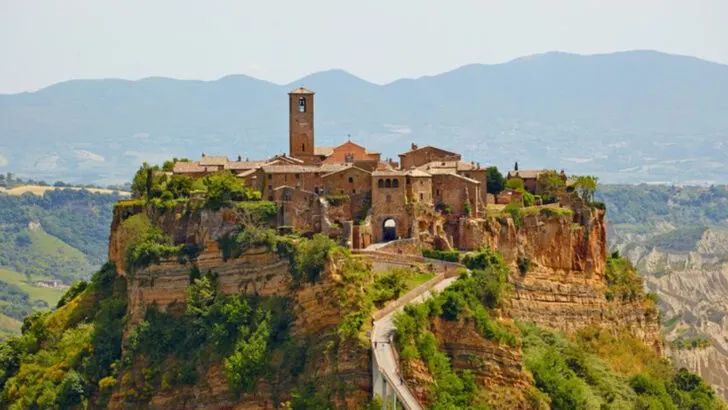Some places whisper history. Viterbo sings it from its stone walls. Tucked between Rome and Florence, this medieval jewel refuses to be overlooked. While tourists swarm Tuscany’s big-name cities, Viterbo quietly guards its secrets—ancient baths, papal palaces, and alleyways straight out of a Renaissance painting. It’s not polished. It’s powerful. And that’s the beauty of it. Here, popes once walked through Gothic archways. Centuries-old thermal springs still bubble with volcanic heat. And every September, an enormous glowing tower—yes, an actual tower—is carried on the backs of men through the cobbled streets. Viterbo doesn’t just preserve the past. It lives in it. And if you’re lucky enough to wander through its medieval heart, don’t be surprised if you start believing you’ve time-traveled.
San Pellegrino: Italy’s Best-Preserved Medieval Quarter
Wander cobblestone lanes lined with stone towers, arched passageways, and ivy-covered balconies. Viterbo’s San Pellegrino neighborhood feels frozen in the 13th century, offering a cinematic medieval experience without the crowds.
Palazzo dei Papi: Where Popes Once Ruled
This striking Gothic palace was the papal residence in the 1200s, and it’s here that the first papal conclave was held. The view from the loggia alone is worth the visit, but history lovers will be drawn to its sacred political legacy.
The Thermal Baths of Viterbo (Terme dei Papi)
For centuries, people have soaked in these natural hot springs, including ancient Romans and Renaissance nobles. The massive outdoor pool is fed by volcanic springs and offers relaxation surrounded by hills and sky.
Viterbo Cathedral (Cattedrale di San Lorenzo)
Set atop ancient ruins, this understated Romanesque cathedral is tied to papal history and houses beautiful frescoes, relics, and a bell tower that dominates the skyline.
Villa Lante: Italian Renaissance Garden Masterpiece
Just outside Viterbo, Villa Lante is a symphony of fountains, symmetrical terraces, and manicured hedges. It’s one of the finest examples of an Italian Mannerist garden and perfect for a romantic afternoon stroll.
The Macchina di Santa Rosa Festival
Every September 3rd, locals carry a massive illuminated tower—over 90 feet tall—through Viterbo’s narrow streets in honor of their patron saint. It’s a jaw-dropping mix of faith, pageantry, and sheer strength.
Piazza della Morte: A Chillingly Beautiful Square
Don’t let the name scare you—this small square in San Pellegrino is a peaceful, photogenic corner with a centuries-old fountain and moody stone facades that beg for quiet reflection.
Etruscan Roots: Underground Viterbo
Beneath the city lies a web of ancient tunnels and chambers dating back to the Etruscans. Guided tours reveal secret passageways, wells, and the city’s forgotten layers of history.
Local Cuisine: Acquacotta and Viterbo’s Rustic Flavors
Viterbo’s traditional food is humble, hearty, and hyper-local. Try acquacotta (a vegetable-and-egg soup), lombetto, and chestnut-based desserts made with ingredients from the surrounding countryside.
Viterbo’s Walls and City Gates
Unlike many cities, Viterbo’s medieval walls still stand—almost entirely intact. You can walk portions of the perimeter and pass through ancient gates like Porta Fiorentina and Porta Romana.
The Viterbo Christmas Market (Mercatino di Natale)
Come winter, Viterbo transforms into a twinkling fairytale. The old town fills with festive stalls, medieval-style performances, and warm street food under glowing lights.
Perfect Day Trips: Civita di Bagnoregio and Lake Bolsena
Just a short drive away, you’ll find the “dying town” of Civita di Bagnoregio, perched on a crumbling cliff, and Lake Bolsena, a volcanic lake perfect for swimming, sailing, and lakeside dining.

